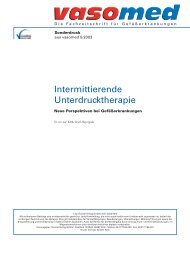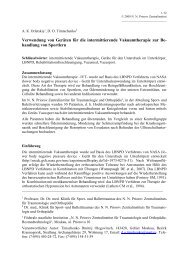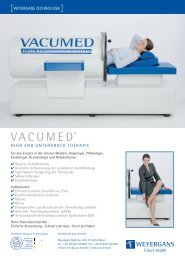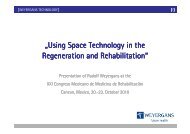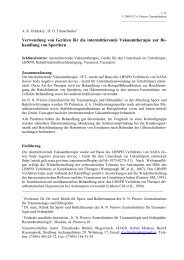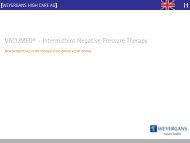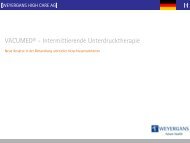Intermittent vacuum, lower body negative pressure ... - vacumed
Intermittent vacuum, lower body negative pressure ... - vacumed
Intermittent vacuum, lower body negative pressure ... - vacumed
- No tags were found...
Create successful ePaper yourself
Turn your PDF publications into a flip-book with our unique Google optimized e-Paper software.
There are also examinations of clinical application of intermittent <strong>vacuum</strong> therapy for patientswith chronic cardiac insufficiency (Wolthuis RA et a., 1974).Effects on AthletesThe effect of manual massage or lymphatic drainage during rehabilitation of athletes is wellknown. In this method, venous backflow is stimulated and circulation of arterial and venousblood is increased, which results in increased venous backflow and cardiac output. In addition,muscle tone and concentration of endorphins in the brain is increased.The effectiveness of intermittent <strong>negative</strong> <strong>pressure</strong> therapy was examined during therehabilitation of 50 professional athletes (canoeists, swimmers, rowers, footballers, tennisplayers and track-and-field athletes). Within 12 weeks, the athletes underwent training followingtheir specific programmes. Half of these athletes received a 30-minute treatment of intermittent<strong>negative</strong> <strong>pressure</strong> by Vacumed every two days (-40 to -50 mbar, duration of the phases ofnormal/<strong>negative</strong> <strong>pressure</strong>: 7/5 sec). Simultaneously, all athletes participated in rehabilitationprogrammes developed by their trainers. The blood of all athletes was examined twice per weekbefore and after training. At the beginning and at the end of the examination, all athletesunderwent an extensive stress test. Before every training, all athletes were interviewed.A total of 1,200 blood examinations were conducted, which proof for the examined group(1.48mmol/l) in comparison with the control group (1.59 mmol/l) in the resting phase before thetraining. The examined athletes produced a smaller concentration of urea and uric acid (40 and3.9 mg/dl compared to 43 and 4.85 mg/dl for the control group); also, a <strong>lower</strong>ed creatine kinasewas found (262 U/l compared to 284 U/l). According to the results of the survey, the athletestreated with intermittent <strong>negative</strong> <strong>pressure</strong> therapy were more motivated in their exercises incomparison to the control group; they also had a better muscle tone and an overall betterrehabilitation (Alf DF, 2007).Clinical Experience of the Central Institute for Traumatology and OrthopaedyAt the N. N. Priorov Central Institute for Traumatology and Orthopaedy, department of sportsand ballet injuries, 30 patients, all professional athletes, were treated by means of theVacusport device following arthroscopic meniscus resection and stabilizing interventions on thefront and rear knee joints after intermittent <strong>vacuum</strong> therapy. For reasons of comparison, 30similar patients were selected, who received the traditional treatment. The treatment withintermittent <strong>negative</strong> <strong>pressure</strong> therapy began at the earliest seven days after the surgicaltreatment after removal of the sutures.Indications were: An oedema after operation, pain and fluid in the knee joint. Counterindications were: Infections, chronic diseases in the exacerbation phase, vascular thrombosis ofthe <strong>lower</strong> extremities. To avoid thrombo-embolic complications, all patients underwentmandatory examination of the vessels of the <strong>lower</strong> extremities by ultrasound Doppler-graphy.The existing Vacusport allowed generation of <strong>negative</strong> <strong>pressure</strong> intervals of 6 up to 12 secondswith normal <strong>pressure</strong> intervals of 5 up to 10 seconds at a <strong>negative</strong> <strong>pressure</strong> of -30 up to -60mbar, adjustable in 5 mbar increments, according to the saved programmes.Picture. 3. Control panel of the device for intermittent <strong>negative</strong> <strong>pressure</strong> therapy.<strong>Intermittent</strong> <strong>vacuum</strong> therapy was used daily in at least 10 treatments of 30 minutes eachaccording to the following schedule:- 1st – 6th minute: 35 mbar / 8 sec. <strong>negative</strong> <strong>pressure</strong> / 10 sec. pause- 7th -12th minute: 45 mbar / 10 sec. <strong>negative</strong> <strong>pressure</strong> / 8 sec. pause- 13th -18th minute: 55 mbar / 8 sec. <strong>negative</strong> <strong>pressure</strong> / 10 sec. pause- 19th - 24th minute: 60 mbar / 10 sec. <strong>negative</strong> <strong>pressure</strong> / 8 sec. pause- 25th - 30th minute: 50 mbar / 8 sec. <strong>negative</strong> <strong>pressure</strong> / 8 sec. pauseAll patients recovered well after the treatments and felt pleasant sensations in their legs afterthe third treatment. In comparison with the other patients (control group of 20 athletes) who didnot receive intermittent <strong>vacuum</strong> therapy, the examined patients showed a faster reduction of theoedema by 2 – 6 days (average 3.5) and reported less pain during physiotherapy. The check-up



